
Introduction and application of 6 common 40G QSFP+ optical module models
In recent years, cloud computing and big data have become an upsurge in our country. In order to provide sufficient bandwidth, many access switches have developed to core switches that can connect to 40G Ethernet. The rapid development of interconnected data transmission is inseparable from the 40G optical module, because it can provide enough bandwidth to ensure that data conversion is unimpeded, thereby meeting the network requirements of data centers and enterprise parks.
The 40G optical module has 4 independent transmit and receive optical signal channels, which can provide high-density and low-power 40G Ethernet connection transmission applications for data centers, high-performance computing networks, enterprise core and distribution layers, and telecom operators. Next, ETU-LINK will introduce the classification of 40G optical modules and the introduction and application of 40G QSFP+ optical modules.
Classification of 40G optical modules
Currently on the market, 40G optical modules are more common in two types: CFP and QSFP+ optical modules.
1. The 40G CFP optical module is specially designed for 40G Ethernet links on single-mode optical fibers, conforms to the RoHS-6 standard, and provides digital diagnostic functions through the MDIO interface designated by CFIO MSA;
2. 40G QSFP+ optical module is a product developed on the basis of QSFP, which is dedicated to high-density applications. Compared with traditional SFP+ optical modules, the port density is higher and the overall system cost is lower. It has four data transmission channels, and the transmission rate of each channel is about 10Gbps. The simultaneous transmission of four channels can achieve a transmission rate of 40Gbps.
Introduction and application of 40G QSFP+ optical module
1. QSFP-40G-SR4 optical module
40G SR4 QSFP+ optical module: center wavelength is 850nm, MPO/MTP interface, multi-mode, supports DDM, operating temperature is 0°C to 70°C, transmit optical power is -7.6 to +0.5dBm, commonly used in data centers.
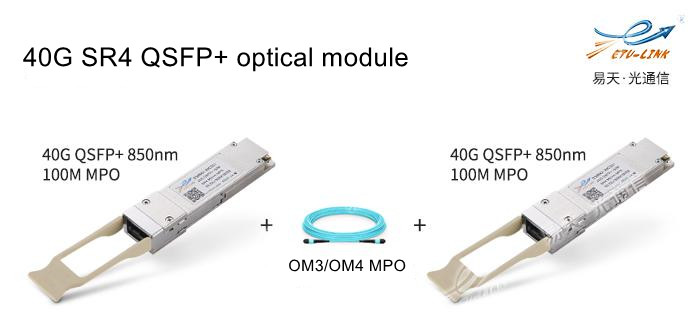
The matching scheme of patch cord:
(1) With OM2, the maximum transmission distance is 30M.
(2) With OM3, the maximum transmission distance is 100M.
(3) With OM4, the maximum transmission distance is 150M.
2. QSFP-40G-eSR4 optical module
40G eSR4 QSFP+ optical module: center wavelength is 850nm, MPO/MTP interface, multi-mode, supports DDM, operating temperature is 0°C~70°C, transmit optical power is -7.6 to +0.5dBm, commonly used in 40G Ethernet and Metro Optical Transport Network.
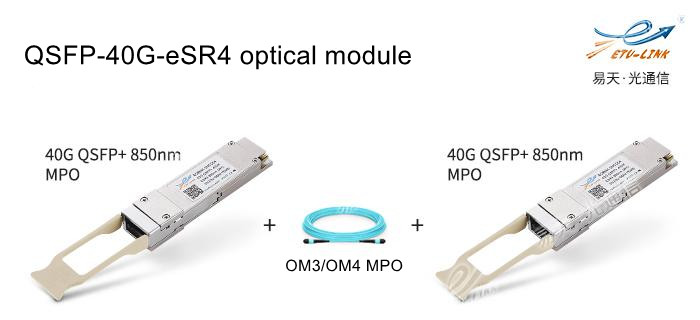
The matching scheme of patch cord:
(4) With OM2, the maximum transmission distance is 82M.
(5) With OM3, the maximum transmission distance is 300M.
(6) With OM4, the maximum transmission distance is 400M.
3. QSFP-40G-PSM4 optical module
40G PSM4 QSFP+ optical module: center wavelength is 1310nm, MPO/MTP interface, single mode, support DDM.
40G PSM4 QSFP+ optical modules are generally used in 40G Ethernet, Fibre Channel and PCIe interconnect solutions with single-mode patch cord OS2, and the transmission distance can reach up to 2KM.
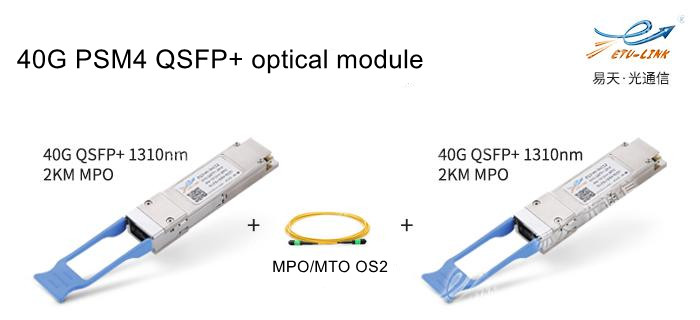
4. QSFP-40G-LR4 optical module
40G LR4 QSFP+ optical module: center wavelength is 1271nm, 1291nm, 1311nm, 1331nm, duplex LC interface, single mode, supports DDM, operating temperature is 0°C to 70°C, and transmit optical power is -7 to +2.3dBm. Generally used with single-mode patch cord OS2 for data center interconnection and metro optical transmission network, the transmission distance can reach up to 10KM.
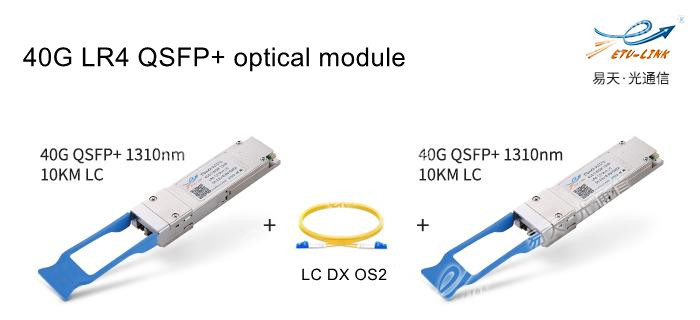
5. 40G eSM4 QSFP+ optical module: center wavelength is 1310nm, MPO interface, single mode, support DDM, working temperature 0-70 degrees Celsius. Generally used with single-mode patch cord OS2 between the data center and the Internet exchange point, its transmission distance can reach up to 10KM.
6. QSFP-40G-ER4 optical module
40G ER4 QSFP+ optical module: center wavelengths are 1271nm, 1291nm, 1311nm, 1331nm, duplex LC interface, single mode, support DDM, working temperature is 0°C~70°C, transmit optical power is -2.7 to +4.5dBm. Generally, it is used in data center and metro optical transmission network with single-mode patch cord OS2, and the transmission distance can reach up to 40KM.
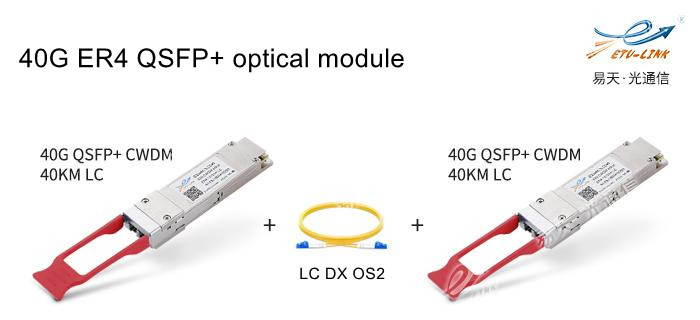
7. QSFP-40G-SR-BD optical module
40G BIDI QSFP+ optical module: center wavelength is 850nm, 900nm, duplex LC interface, multi-mode, supports DDM, operating temperature is 10°C~70°C, and transmit optical power is -4 to +5dBm. The optical module actually uses two 20G single-fiber bidirectional technology for transmitting and receiving, and two LC interface multi-mode fibers are required.
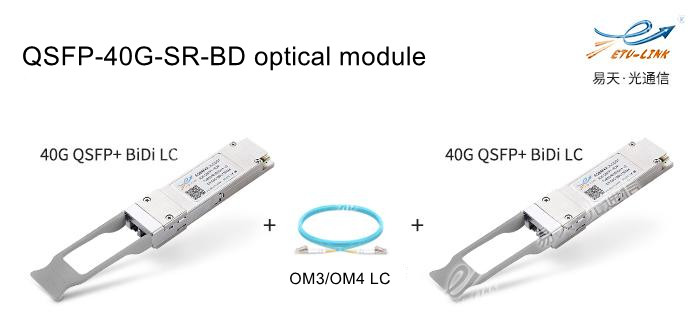
The matching scheme of patch cord:
(7) With OM3, the maximum transmission distance is 100M.
(8) With OM4, the maximum transmission distance is 150M.
Finally, the emergence of 40G optical modules simplifies the network architecture and reduces the number of accessories. As an optical module manufacturer, ETU-LINK can provide all of the above products, and the products are compatible with brand switches such as Huawei, Cisco, H3C, and Ruijie.
In metro backbone network applications, its scheduling and integration are far superior to four 10G systems, which can save computer room area, reduce equipment stacking, and improve the bandwidth management and scheduling capabilities of single-node equipment, effectively reducing costs. More importantly, it is more economical than other metropolitan area network solutions.
Categories
New Blog
Tags
© Copyright: 2025 ETU-Link Technology CO ., LTD All Rights Reserved.

IPv6 network supported
Friendly Links:
易天官网